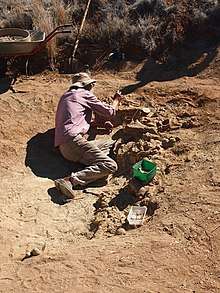Alcoota
The Alcoota Fossil Beds are an important paleontological site in the Northern Territory of Australia located on Alcoota Station in the locality of Anmatjere[1] about 115 kilometres (71 mi) north-east of Alice Springs in the Central Australia region. It is notable for the occurrence of well-preserved, rare, Miocene vertebrate fossils, which provide evidence of the evolution of the Northern Territory’s fauna and climate. The Alcoota Fossil Beds are also significant as a research and teaching site for palaeontology students.
| Alcoota Fossil Beds | |
|---|---|
 Latz's pit, Alcoota fossil site, NT | |
| Location | Anmatjere, Northern Territory, Australia |
| Coordinates | 22°51′39.6″S 134°25′5.9″E |
| Area | 48.88 hectares (120.8 acres) |
The Alcoota deposit is a series of intermittently interconnected lakes within a large basin. Evidence suggests that the concentration of fossils is due to a phenomenon called ‘waterhole-tethering’: During dry periods, animals concentrated in the immediate area of the continually shrinking, spring-fed lake, resulting in the death of many animals. The Alcoota and Bullock Creek fossil faunas provide evidence that aridification was in progress in northern Australia during the mid-Miocene geological time period.
History
The Alcoota Fossil Beds are one of only three known vertebrate fossil sites in the Northern Territory, along with Bullock Creek and the Kangaroo Well site. Although locals had known about the existence of fossils at Alcoota for a long time, the first serious studies were not conducted until 1962. Further excavations were conducted sporadically until 1984 when the Museum and Art Gallery of the Northern Territory commenced an annual excavation program. In 1988, a permanent field station was erected on-site and the valuable Alcoota Beds were fenced provide them with some protection.
The Alcoota fauna is about 8 million years old and has a rich concentration of vertebrate fossils. This makes it especially interesting, as it lies between the older faunas of Kutjamarpu (Southern Australia) and Bullock Creek (Northern Territory) and the younger deposits of Riversleigh (Queensland) and Beaumaris (Victoria). Because of its intermediate age, remote ancestors of the well-studied Australian megafauna as well as of some existing forms can be recognised.
Fossils
The fossil deposit consists of a series of bone-bearing lenses on a single horizon. The individual lenses are about 1 m across and extend for 170 m. Bones and teeth are so abundant and often tightly packed, excavating one fossil without breaking the one below it can be difficult. The fossils indicate the existence of a complex community of marsupials, birds, and crocodiles, including the greatest variety of species of Diprotodontidae that has ever been described.
The species found include one of the largest birds that ever lived, Stirton's thunderbird (Dromornis stirtoni), the giant birds Ilbandornis lawsoni and Ilbandornis woodburnei, the wolf-sized powerful thylacine (Thylacinus potens), and the large leopard-sized Alcoota marsupial lion (Wakaleo alcootaensis). Also found at Alcoota are fossils of herds of the wombat-like diprotodontoids Kolopsis torus and Plaisiodon centralis, the trunked Palorchestes painei, Pyramios alcootense and other kangaroos, crocodiles, bandicoots, possums, and small birds.
Heritage listing
In 1995, land described as "Northern Territory Portion 4075" and covering an area of 48.88 hectares (120.8 acres) was added under the name "Alcoota Fossil Beds" to the Northern Territory Heritage Register.[1][2]
See also
- List of fossil sites (with link directory)
References
- "Alcoota Fossil Beds". Heritage Register. Northern Territory. 8 February 1995. Retrieved 27 October 2019.
- Coulter, Barry (8 February 1995). "Heritage Conservation Act - Declaration of Heritage Place". Northern Territory Government. Retrieved 27 October 2019.
- Murray, P. and Megirian, D. 1992. Continuity and Contrast in middle and late Miocene Vertebrate Communities from the Northern Territory. The Beagle 9:195–218.
External links
| Wikimedia Commons has media related to Alcoota fossil beds. |
- Australia's Lost Kingdoms – Late Miocene period – About Alcoota
- Alcoota Fossil Beds – Government of the Northern Territory
- Giant fossil claw may be from ancient reptile – By Caddie Brain – Australian Broadcasting Corporation